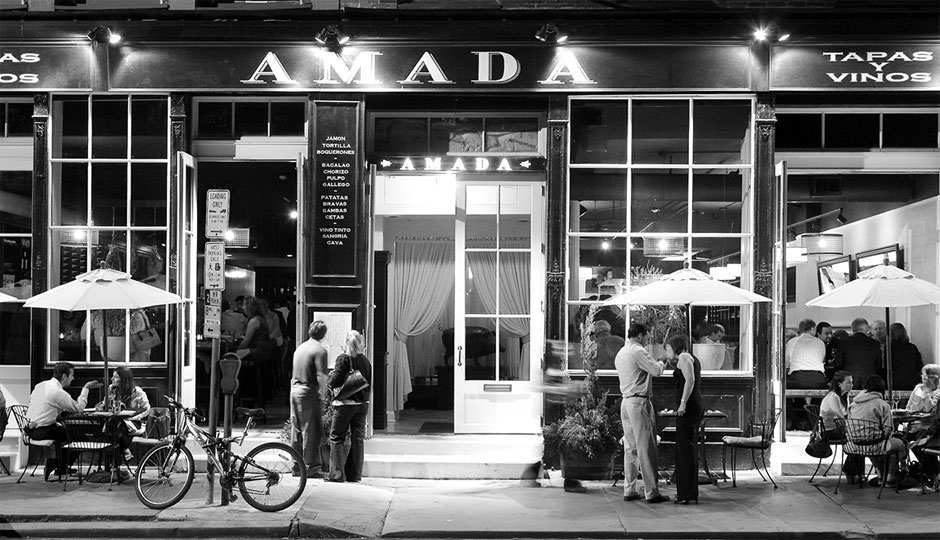The Revisit: Amada

Amada | Courtesy of Garces Group
When he opened Amada nine years ago, Jose Garces had two visions for his debut restaurant. Only one survived—succeeding so lucratively that it suffocated the other.
You can still visit the latter’s burial place, though: just ask for one of the best six seats in the house.
“When I initially did Amada,” Garces reminisced back in May, “there’s a six-person counter next to kitchen. The thought was that’s where I could unleash my creativity and do highly creative meals for small groups.”
But even if he’d been able to get all the fancy kitchen equipment he really wanted, Amada’s mass-market tapas formula was just too powerful a juggernaut to rein in. “It got really busy,” Garces recalls. “Those seats were swallowed up before I knew it.”
But they remain a prime perch from which to watch Amada’s phalanx of cooks–led for the last year by Garces Group journeywoman Maria Schmidt–hustle to bring a giant menu to an even bigger crowd. So prime, indeed, that I had a Sixer’s chance at a 2014 title of scoring four of them on a recent weeknight. Just booking any table, between 5:30 and 9 o’clock, took some doing three days ahead of time.
One could offer any number of reasons for Amada’s enduring popularity. Out-of-towners come for an affordable taste of a chef who went national quite a while ago now (even if he’s spending more of his in-town time at Volver, where he’s finally realized that early boutique vision). Local diners rightly revere Amada for its consistency—and a management team that knows how to fix the mistakes that are inevitable at a restaurant that can push out something like a thousand tapas on a busy night. (Five years ago I was part of a group disgruntled by the service of Amada’s suckling pig dinner. The organizer of our 12-person outing later conveyed our disappointment to the general manager, who responded by issuing a $75 gift certificate to each couple good for any Garces place in town. Because that is how you turn a bitter taste into good will.)
But here’s a better reason–and really, the only one I needed to explain the healthy crowd as I checked in for the first time since that suckling pig: Amada’s titular empanadas. They’re stuffed with wilted spinach and manchego, and served over an escabeche of artichokes and piquillo peppers…but I’d order them even if they were packed with Velveeta and a can of bomb-shelter greens. The dough, handmade daily from boiled plantains fluffed up by multiple passages through a food mill, makes these thin-walled crescents the lightest and most delicate savory pastries in town–and, come to think of it, the best empanadas I’ve ever eaten anywhere. The intensely flavored escabeche just gilds an already flawless lily.
Plenty of chefs name restaurants after loved ones, and some double-down by naming a dish after them too. Judging exclusively from Garces’ rendition of his Mamita Amada’s empanadas de verde, the Iron Chef had the kind of grandmother you’d trade your own for come supper time.
But Schmidt and her team did right by plenty of other dishes, too. Flash-fried Padron peppers came on a nutty salbitxada sauce whose double-dose of sherry vinegar was mellowed by a touch of honey that neatly foiled the occasional bursts of heat from the chilies. A flatbread with pork shoulder, broccoli rabe, and tiny pickled guindilla chilies imbued that classic Philadelphia combination with figgy Spanish sweetness. Tasmanian sea trout–which is more commonly known as steelhead and could have fooled me for Arctic char–had a crispy skin, a touch of chorizo, and an artichoke cream sauce that pushed the fatty fish just over the line into decadence.
A couple dishes stepped a little too far over that line for me. The fideos, rich with seared scallops and calamari sliced so thin that the strands melded into the background camouflage of vermicelli, drowned in a more overwhelming richness of a heavy cream reduction sweetened with caramelized onions. I’d never encountered a spin on fideos featuring any cream at all, much less enough to transform that dish’s essential half-dry character into a soggy white almost-soup. I had a similar reaction to the crab-stuffed piquillo peppers. I’m open to an argument for enriching the crab with cream or San Simone cheese–but perhaps not both at once. At least not quite to level that quashed the crab flavor in the ones that came our way.
But even those two errors on the side of richness (which, I should add, won more praise than complaint from my companions) hardly impaired our enjoyment. From a welcoming plate of crackers with a chunky tuna dip to a deconstructed cheesecake topped with a refreshing scoop of Meyer lemon sorbet, the meal was a well-paced trip orchestrated by servers who always seemed to pop up when needed and a kitchen that’s chugging along in the groove. Better still, the bar team here hasn’t let things go stale. My sip of a rosado sangria left me with a little too much sugar on my tongue, but the discovery of Ameztoi’s superb dry Txakolina rosé—a rare by-the-glass find given that the vast majority of Txakolina is white—was $14 well spent. Or the same amount would buy two glasses of funky Isastegi Sagaro unfiltered cider. Decisions, decisions…
Amada serves a lot of food and drink to a lot of people. But though mass-market is frequently a synonym for mediocrity, it can also have a finer, more democratic meaning. And one of the most winning things about Amada, which buzzes as energetically (and loudly) as ever in its ninth year, is the diversity of its clientele. Older folks, younger folks, skin of every hue: it’s a pleasure to find, in this old favorite, a vision of the polyglot city that represents Philadelphia’s best possible future. Much of the food here strikes universal chords, and the atmosphere welcomes all comers.
Garces may have had to wait for another time, and another place, to craft ultra-creative meals for the one percent. But Amada’s resonance with meal seekers of more varied stripes is no lesser achievement.
Amada [f8b8z]


